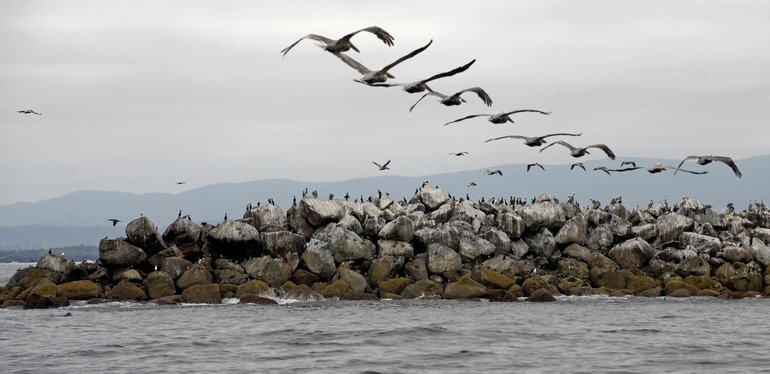Amateur hydrologists might suggest that the mouth of the Columbia River more closely resembles a nozzle. While many other rivers have deltas that more gently distribute the current and sediment, the Columbia River is a more direct pipeline that shoots drainage from 258,000 square miles (seven states and one province) into the Pacific Ocean. The estuary widens to several miles near the ocean, but it remains a single downstream route.
For more than a century, controlling that nozzle and the resultant turbulence of the Columbia River bar has been no small task. Construction of the 6.5-mile south jetty began in 1885 and took more than 30 years. The 2.5-mile north jetty was finished in 1917. Together, they keep the river moving on a swift and narrow path, reducing the accumulation of silt and allowing sediment to be distributed by the ocean on the back sides of the jetties, out of the shipping channel.
The jetties have worked magnificently, but they’re deteriorating, and that puts a huge shipping industry at risk. Overall, Columbia River shipping supports about $16 billion in economic activity stretching as far east as Idaho. At the Port of Vancouver alone, ship dockings have averaged about 500 annually over the last several year.
A solution to the crumbling jetties has been proposed by federal engineers, and as Erik Robinson reported last week in The Columbian, the answer is neither cheap nor quick. Repairing the jetties is expected to cost $400 million to $470 million, and the work will be done in phases over 18 years.
The Army Corps of Engineers deserves praise for designing a project that will protect the regional economy and keep the river operating the way it should. Congress is urged to act swiftly on the proposal so that work can begin as soon as 2012.
History suggests that Congress is willing to take such a bold step. The results of massive federal appropriations are scattered throughout the river basin, most significantly in the dam system. It is that dam system that has created part of the problem at the jetties. The corps estimates that, between 1885 and 1925, the nozzle shot out between 500 million and 800 million cubic yards of sand into the ocean. Waves pushed the silt onto the outsides of the jetties — strengthening the huge rock walls — and moved other amounts to expanded public beaches. But since construction of the Columbia River dams, two-thirds of that sand has been captured behind the dams, and the jetties have lost much of their source of base strength.
Another more recent example of congressional commitment to protect and enhance the Columbia River economy has been the $190 million deepening of the shipping channel from 40 feet to 43 feet between the ocean and the Vancouver-Portland area. That will boost the shipping industry by allowing ships with larger cargos to dock here.
If and when Congress green-lights the repair of the jetties, the work will go out to bid. It’s uncertain how much Clark County could benefit from the project, but the impact could be significant. More than a century ago, much of the jetty rock came from Fisher’s Quarry basalt rock mined near Camas. How much the $400 million, 18-year project will contribute to local business could also depend on which bids are accepted for the numerous other aspects of the work. But two glaring realities are certain. The jetties must be strengthened, and a gigantic shipping industry is at risk if Congress does not act quickly.



